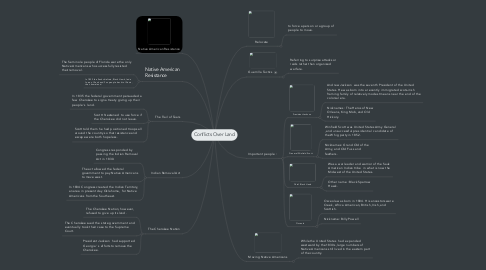Conflicts Over Land
저자: nakiya warren

1. Relocate
1.1. to force a person or a group of people to move.
2. Guerrilla Tactics
2.1. Referring to surprise attacks or raids rather than organized warfare.
3. Important people :
3.1. President Jackson
3.1.1. Andrew Jackson was the seventh President of the United States. He was born into a recently immigrated scots-irish framing family of relatively modest means near the end of the colonial era.
3.1.2. Nicknames: The Heros of New Orleans, King Mob, and Old Hickory.
3.2. General Winfield Scott
3.2.1. Winfield Scott was United States Army General , and unsuccessful presidential candidate of the Whig party in 1852.
3.2.2. Nicknames: Grand Old of the Army, and Old Fuss and feathers.
3.3. Chief Black Hawk
3.3.1. Was a war leader and warrior of the Sauk American Indian tribe in what is now the Midwest of the United States.
3.3.2. Other name : Black Sparrow Hawk.
3.4. Osceola
3.4.1. Osceola was born in 1804. His ancestors were Creek, Africa American, British, Irish, and Scottish.
3.4.2. Nickname: Billy Powell
4. Moving Native Americans
4.1. While the United States had expanded westward by the 1830s, large numbers of Native Americans still lived in the eastern part of the country.
5. Native American Resistance
6. Native American Resistance
6.1. The Seminole people of Florida were the only Native Americans who successfully resisted their removal .
6.2. In 1832 the Sauk chieftain, Black Hawk, led a force of Sauk and Fox people back to Illinois, their homeland.
7. The Trail of Tears
7.1. In 1835 the federal government persuaded a few Cherokee to sign a treaty giving up their people's land.
7.2. Scott threatened to use force if the Cherokee did not leave.
7.3. Scott told them he had positioned troops all around the country so that resistance and escape were both hopeless.
8. Indian Removal Act
8.1. Congress responded by passing the Indian Removal Act in 1830.
8.2. The act allowed the federal government to pay Native Americans to move west.
8.3. In 1834 Congress created the Indian Territory, an area in present day Oklahoma, for Native Americans from the Southeast.
9. The Cherokee Nation
9.1. The Cherokee Nation, however, refused to give up its land.
9.2. The Cherokee sued the state government and eventually took their case to the Supreme Court.
9.3. President Jackson had supported Georgia ' s efforts to remove the Cherokee.

